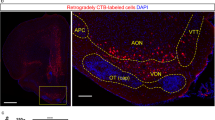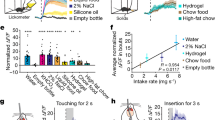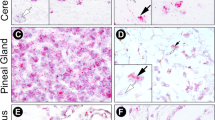Abstract
Dynorphin is a 17 amino acid opioid peptide which was originally isolated and characterized from pig neurohypophysis and gut extracts1–3. It contains a leucine-enkephalin (Leu-enkephalin) sequence at the amino terminus and has an unusually potent in vitro opiate activity in the guinea pig ileum longitudinal muscle/myenteric plexus preparation1–4. Immunohistochemical studies have shown that perikarya, nerve fibres and terminals widely distributed throughout the central nervous system5,6 are immunoreactive for both dynorphin1–17 and α-neo-endorphin6,7, another Leu-enkephalin-containing opioid peptide which is structurally related to dynorphin (Fig. 1) and was isolated from hypothalamus8. But although the regional distributions of α-neo-endorphin and dynorphin1–17 in rat brain, as measured by radioimmunoassay (RIA), are similar, the molar ratio of the two peptides seems to vary greatly from region to region, with α-neo-endorphin being present in much higher concentrations than dynorphini1–17 9–11. We now report that dynorphin1–8, an amino-terminal fragment (Fig. 1), which has only ∼3% of the opioid potency of dynorphin1–17, (ref. 4), is present in up to 10-fold higher concentrations in brain than dynorphhi1–17 immunoreactivity. We further show that dynorphin1–8, but not dynorphin1–17, occurs in approximately equimolar concentrations with α-neo-endorphin in all brain regions examined, suggesting a close biosynthetic relationship between α-neo-endorphin and dynorphin1–8.
This is a preview of subscription content, access via your institution
Access options
Subscribe to this journal
Receive 51 print issues and online access
$199.00 per year
only $3.90 per issue
Buy this article
- Purchase on Springer Link
- Instant access to full article PDF
Prices may be subject to local taxes which are calculated during checkout
Similar content being viewed by others
References
Goldstein, A., Tachibana, S., Lowney, L. I., Hunkapillar, M. & Hood, L. Proc. natn. Acad. Sci. U.S.A. 76, 6666–6670 (1979).
Goldstein, A., Fischli, W., Lowney, L., Hunkapillar, M. & Hood, L. Proc. natn. Acad. Sci. U.S.A. 78, 7219–7223 (1981).
Tachibana, S., Araki, K., Ohya, S. & Yoshida, S. Nature 295, 339–340 (1982).
Chavkin, C. & Goldstein, A. Proc. natn. Acad. Sci. U.S.A. 78, 6543–6547 (1981).
Watson, S. J., Akil, H., Ghazarossian, V. E. & Goldstein, A. Proc. natn. Acad. Sci. U.S.A. 78, 1260–1263 (1981).
Weber, E., Roth, K. A. & Barchas, J. D. Proc. natn. Acad. Sci. U.S.A. 79, 3062–3066 (1982).
Weber, E., Roth, K. A. & Barchas, J. D. Biochem. biophys. Res. Commun. 103, 951–958 (1981).
Kangawa, K., Minamino, H., Chino, N., Sakakibara, S. & Matsuo, H. Biochem. biophys. Res. Commun. 99, 871–877 (1981).
Goldstein, A. & Ghazarossian, V. Proc. natn. Acad. Sci. U.S.A. 77, 6207–6210 (1980).
Minamino, N., Kitamura, K., Hayashi, Y., Kangawa, K. & Matsuo, H. Biochem. biophys. Res. Commun. 102, 226–234 (1981).
Maysinger, D. et al. Neuropeptides (in the press).
Minamino, N., Kangawa, K., Fukuda, A. & Matsuo, H. Biochem. biophys. Res. Commun. 95, 1475–1481 (1980).
Seizinger, B., Hollt, V. & Herz, A. Biochem. biophys. Res. Commun. 102, 197–205 (1981).
Weber, E., Evans, C. J., Chang, J-K. & Barchas, J. D. J. Neurochem. 38, 436–447 (1982).
Zakarian, S. & Smyth, D. G. Proc. natn. Acad. Sci. U.S.A. 76, 5972–5976 (1979).
Herman, B. H., Leslie, F. & Goldstein, A. Life Sci. 27, 883–892 (1980).
Leslie, F. M. & Goldstein, A. Neuropeptides (in the press).
Chavkin, C., James, I. F. & Goldstein, A. Science 215, 413–415 (1982).
Hewlett, W. A., Akil, H. & Barchas, J. D. Abstr. Proc. int. Narcotics Res. Conl. Kyoto, Japan, 9 (Kodansha, Tokyo, 1981).
Glowinsky, J. & Iversen, L. J. Neurochem. 13, 655–669 (1966).
Author information
Authors and Affiliations
Rights and permissions
About this article
Cite this article
Weber, E., Evans, C. & Barchas, J. Predominance of the amino-terminal octapeptide fragment of dynorphin in rat brain regions. Nature 299, 77–79 (1982). https://doi.org/10.1038/299077a0
Received:
Accepted:
Published:
Issue Date:
DOI: https://doi.org/10.1038/299077a0
This article is cited by
-
Aversive Stress Reduces Mu Opioid Receptor Expression in the Intercalated Nuclei of the Rat Amygdala
Cellular and Molecular Neurobiology (2021)
-
Dynorphin Counteracts Orexin in the Paraventricular Nucleus of the Thalamus: Cellular and Behavioral Evidence
Neuropsychopharmacology (2018)
-
The dynorphin/κ-opioid receptor system and its role in psychiatric disorders
Cellular and Molecular Life Sciences (2012)
Comments
By submitting a comment you agree to abide by our Terms and Community Guidelines. If you find something abusive or that does not comply with our terms or guidelines please flag it as inappropriate.



